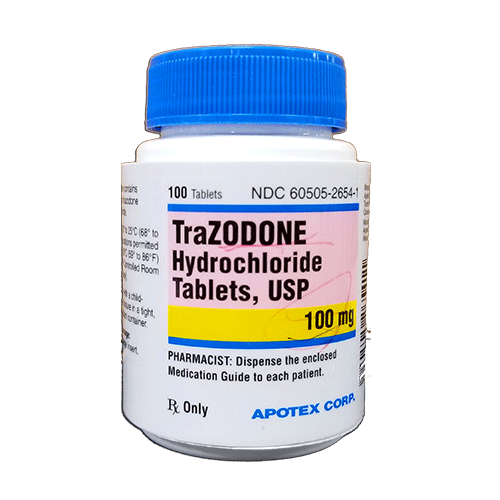Trazodone can reliably and safely induce sedation and anxiolytic effects in dogs and cats, making it a useful pharmacological agent for treating behavior problems.

INDICATIONS
Trazodone is clinically used in both dogs and cats; However, its use has been more widely studied in dogs.
? Situational anxiety associated with
• Separation (the owner leaves the dog for a while)
• Noise phobias (eg fireworks, thunderstorm)
• Visiting a veterinarian
• Hospitalization
• Journey
? Postoperative hospital
? Adjunctive therapy is used in combination with other psychopharmaceuticals to treat behavioral problems associated with anxiety (for example, fear of humans or other animals)
Pharmacology & Clinical Applications
Trazodone is an atypical antidepressant used to treat anxiety and depression, belongs to the class of serotonin reuptake antagonists / inhibitors (SSRIs)
Trazodone is most commonly prescribed as an augmentation of selective serotonin reuptake inhibitors (SSRIs) and tricyclic antidepressants (TCAs).
? It globally increases serotonin levels by blocking reuptake in humans and presumably in dogs and cats.
• Higher doses (see Recommended starting dose) are usually required to achieve reuptake inhibition.
? The drug also readily post-synoptically antagonizes serotonin receptors 2A and 2C (5-HT 2A and 5-HT 2C, respectively), thereby inhibiting glutamate release and stimulating dopamine release and norepinephrine release in the prefrontal cortex.
? In addition to antagonizing the serotonin receptor, trazodone is an antagonist of histamine 1 (H 1) and a 1 adrenergic receptors, which leads to a sedative-hypnotic effect.
• Sedation can be achieved at lower doses than those needed to treat anxiolysis (see Recommended starting dose).
• Can be used to facilitate postoperative hospital stay.
? May also help promote rest in other situations (eg, travel / transportation, nighttime anxiety associated with cognitive dysfunction)
The recommended starting dose for dogs is 3-7 mg / kg orally once or twice a day. If the drug is used to treat situational anxiety, the same dose may be administered as needed 1–2 hours before the anticipated event; The dose can be increased until the desired effect occurs.
? When prescribing trazodone for the first time, clients should be instructed to administer the first dose at home in a quiet and relaxed environment to monitor:
• Time of onset of sedation or time of onset of sedation
• Duration of action
• Side effects and other effects
? If a sedative and / or anxiolytic effect is not achieved, the dose or frequency of administration may be increased until the desired effect is achieved.
? Studies have reported a wide range of PO doses up to 14 mg / kg once daily and 19.5 mg / kg once daily.
In dogs, delay to onset of effect is <2 hours after oral administration and may be used as a faster acting sedative / tranquilizer for situational anxiety.
? Anxiety-provoking situations that can be alleviated with trazodone treatment include: veterinary visits, travel / transportation, separation anxiety, and noise phobias associated with fireworks or thunderstorms.
• Trazodone can also be given by veterinary staff to restless hospitalized patients as long as there is no contraindication.
? Proactively giving Trazodone 1-2 hours before the onset of the anxiety state to prevent emotional sensitization.
? The presence of food in the upper gastrointestinal tract may delay the absorption of trazodone.
? For dogs, trazodone can be used on an as needed basis for situational concerns, given daily every 8 to 10 hours, or as needed.
• The duration of the effect is variable.
? Average duration of action when used to relieve postoperative anxiety was ?4 hours.
A recent study in cats showed that trazodone was well tolerated and sedated at doses of 50, 75 and 100 mg.
? Cats reach peak sedation between 2 and 2.5 hours after oral administration.
? Trazodone may be a good alternative to fast-acting anxiolytics in cats that have had side effects on benzodiazepines (eg lorazepam).
? It can be used in similar situations as for dogs.
? Recommended starting dose in adult cats
• 25 mg / cat
• Can be titrated to get the effect
SIDE AND WITHDRAWAL EFFECTS
Adverse effects associated with oral administration of trazodone are generally not observed in dogs and cats.
? Potential effects
include
• Calming down
• Ataxia
• GI effects (eg, vomiting, diarrhea)
• Increased or decreased appetite
• Agitation (excitement, agitated state)
• Tachycardia
• Behavioral disinhibition
? IV administration of trazodone has only been researched in dogs and is not recommended as it can cause aggressive behavior in some dogs.
• The injectable form of trazodone is not commercially available.
Tolerance, withdrawal effects, and dependence have not been reliably proven.
? As a precautionary measure, patients are gradually reduced the daily dose to reduce the likelihood of a withdrawal effect and to continue to monitor the patient for anxiety after trazodone withdrawal.
Clients should be counseled about the risks and clinical signs associated with serotonin syndrome.
If clinical signs are observed, clients should immediately contact their veterinarian or take the pet immediately to the veterinary clinic for emergency treatment. The patient should not receive additional serotonergic medications until evaluated by a veterinarian. Treatment is supportive and focused on solving hyperthermia, as well as maintaining the cardiovascular system, gastrointestinal tract, and control of neurological signs.
For more information on the diagnosis and treatment of serotonin syndrome, see Serotonin Syndrome in the October 2013 Clinician’s Brief.
WARNINGS
Due to the potential risk of serotonin syndrome, caution should be exercised when combining trazodone with other serotonergic drugs and / or monoamine oxidase (MAO) inhibitors.
? Although trazodone is most commonly used to enhance SSRIs and TCAs, care must be taken when given with other drugs.
• Signs of serotonin syndrome include:
? Cardiovascular changes (i.e., tachycardia, bradycardia, arterial hypertension, rhythm disturbances)
? Tachypnea
? Hyperthermia
? Neurological effects (i.e., disorientation, weakness, excitability, agitation, hyperreflexia, hyperesthesia, tremors, seizures, coma)
? GI changes (i.e., vomiting, diarrhea, drooling)
• Signs can lead to death.
? Close observation and monitoring of patients is recommended.
When writing recipes or instructions for trazodone, do not mistake the spelling “tramadol instead of trazodone”.
? On the prescription form, indicate “for treating anxiety.”
? Educate clients about the difference between Trazodone and Tramadol, especially if the animal is receiving both drugs.
5-HT 2A = serotonin 2A receptor, 5-HT 2C = serotonin 2C receptor, SARI = serotonin antagonist / reuptake inhibitor, SSRI = selective serotonin reuptake inhibitor, TCA = tricyclic antidepressant, MAOI = monoamine oxidase inhibitor

